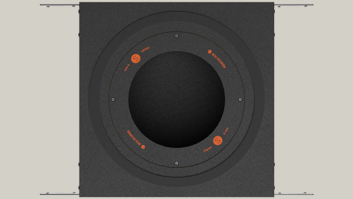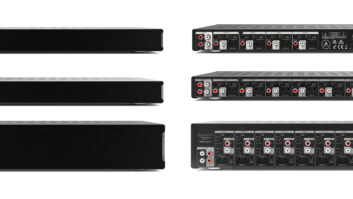Three Movie Clips to Showcase an Immersive Seating Experience
D-BOX is like 3D for your butt, in that it adds another dimension to the experience but one that doesn’t rely on cheap glasses and cardboard cutouts flying off of the screen. Before D-BOX sent a demo system my way though, I always got the sense that being wobbled to and fro for the duration of an entire movie would get old pretty quickly. Much to my surprise, it took me about a film-and-a-half to really get immersed in D-BOX—to view it as a legitimate enhancement of the cinematic experience, not as a simple theme-park gimmick.
The other big surprise for me was just how easy the system installation process was. The entire D-BOX system consists of the Series IV-BD Standalone Motion Controller/Blu-ray reader (which connects to the home theater system via an optical or coaxial digital cable, although sadly not HDMI, and generates the motion codes based on aural cues in a movie’s soundtrack), the motion platform (a series of pistons and metal tubes that can be cut to length to fit different sized couches or recliners), and all of the necessary Ethernet cables required to hook it all up. You’ll also want to add an RS-232-capable control system to the mix because D-BOX doesn’t provide a remote control, but the company does offer little keypads that can be embedded into home theater seating to provide direct and individualized control over the vibration and motion intensity of the experience, just like you get in D-BOX-equipped commercial cinemas.
While theatrical D-BOX is a two-axis system, D-BOX at home benefits from a third axis of motion. And that extra axis goes a long way toward not only elevating the rock ’em sock ’em intensity, but it also adds a whole new layer of subtlety–all of which makes the following clips that much more immersive.
The Dark Knight Rises, Chapter 5

There’s a sequence in The Dark Knight Rises that runs through the entire range of D-BOX motions, from gentle accentuation to outright theme park spectacle. Forget saving the best for last. The third film in Christopher Nolan’s Dark Knight Trilogy is at the top of my list of films that just don’t work as well for me without D-BOX anymore. And the chapter in which Bane robs the Gotham Stock Exchange is a brilliant example of why. The sequence runs through the entire range of D-BOX motions, from gentle accentuation to outright theme park spectacle. It starts subtly, though, with virtually no motion enhancement, until Bane rips off his motorcycle helmet and you, the viewer, literally recoil at every fist blow from his surprise melee assault on the stock exchange guards. As he exits the building with his hostages, the D-BOX system adds a gentle, almost imperceptible sway to the scene to convey the nervousness and unsteady hands of the SWAT soldiers. It’s the getaway that follows in which the precision of the D-BOX system is best demonstrated, though; despite the fact that you’re constantly swaying and jolting to replicate the inertia of the chase, what blows my mind is that you can close your eyes and literally feel whether the camera has you riding in a solid, four-wheeled police car or a tenuous, precarious getaway bike.
The Avengers, Chapter 16–“Avengers Assembled”

The Avengers makes for one of the most thrilling D-BOX experiences. If you’re sensing a superhero theme here, that’s no coincidence. D-BOX makes you feel like a part of the movie, and who among us doesn’t want to strap on a cape and save the world? So it’s no surprise that the movie containing all of Earth’s Mightiest Heroes also makes for one of the most thrilling D-BOX experiences. What surprised me, though, is just how diverse it is. The alien invasion at the climax of the film really gives each hero a chance to strut his or her individual stuff, and it gives the D-BOX system a chance to show just how sophisticated its motion programming can be. When Hulk goes all Smash on the alien invaders, it’s a visceral, hard-edged experience. You literally feel the pavement buckling under your butt. When the extra-terrestrial invaders drop through the dimensional portal in the sky, the simulated falling motion really puts butterflies in your tummy. My favorite thing is how D-BOX makes Iron Man and Thor’s flying scenes feel utterly different and distinct. When the Iron Avenger takes the skies, you feel like you’re being pushed by rocket propulsion. When Thor leaps skyward, you feel like you’re being pulled by Mjolnir (his magical hammer).
Cloud Atlas, Chapter 1

It’s good to have a D-BOX demo like Cloud Atlas on hand, if only to show more timid viewers how much the system can add to headier, more philosophical films. And now for something completely different. While superhero flick and other action extravaganzas may be the bread and butter of D-BOX, you may have clients who simply don’t enjoy that sort of movie. So it’s good to have a D-BOX demo like Cloud Atlas on hand, if only to show more timid viewers how much the system can add to headier, more philosophical films. The opening scenes of The Wachowskis’ time-jumping, intertwining story about the persistence of the human soul is a great demo, in that it shows just how restrained the D-BOX experience can be. The first shot, as the camera pans down from the stars to join Tom Hank’s post-apocalyptic Zachry character around the campfire, is accompanied by a tilt forward that makes you feel like you’re gently swooping from the sky, but also literally tilts you toward the screen, as if you’re leaning in to hear his hushed story. And from there, the D-BOX system mostly remains motionless– even avoiding the obvious rolling waves in the next cut to keep your focus on the dialogue–only kicking back in again to accentuate the rickety suspension of Luisa Rey’s VW Bug in 1973 and the force of Sonmi-451’s magnetic constraints in the year 2144. There are more forceful action scenes later in the film, to be sure, but the selective restraint of the motion in the first chapter really serves to demonstrate just how much value D-BOX can add to virtually any movie experience.







